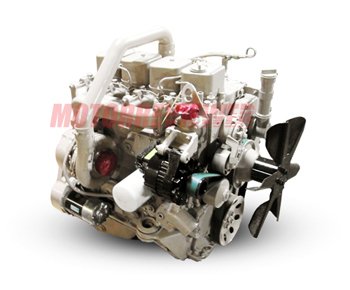Cummins 4BT 3.9L Engine Specs, Problems, Reliability, Info

The 4BT engine is inline four-cylinder water-cooled turbodiesel engine in the Cummins B series. The 3.9-liter strait-four together with 5.9-liter straight-six (12 valve Cummins) are the most popular engines in B series. There are 3.3-liter and 4.5-liter four-cylinder engines also available.
The engine has a cast-iron engine block with engine bores machined directly into the engine block. All 4BT engine blocks are the same, and they have a different transmission adapter plate only depending upon the application. The engine valvetrain is OHV. A camshaft is mounted into the block and driven by a crankshaft through gears in the front end of the engine (as well as the oil pump). The camshaft opens and closes valves pushing through rocker arms by pushrods and solid tappets. The cylinder head is made of cast iron too. The intake and exhaust ports are on opposite sides (crossflow cylinder head). There are eight valves, 2 per cylinder. The 4BT features the mechanical direct injection system. The early versions are equipped with the P7100 mechanical injection pump driven through a gear by camshaft's gear.
The 4BT engine has a turbocharger, but it is not-intercooled. Intercooled version (named as the 4BTA, where letter A means "Aftercooled") has a lower compression ratio of 16.5:1. Low compression and cool air stand for a higher boost. The 4BTA engine produces more power and torque and is more suitable for installation in a small truck or pickup, but keep in mind what the 4BTA is an industrial engine. Automotive charge air-cooled engines have different numbers depending upon model and year of production. There is the industrial naturally aspirated version named the 4B with an 18.5:1 compression ratio also available.
The 4BT is very similar to the 6BT. It has the same architecture, and many parts are interchangeable. The pistons, injectors, connecting rods, valves, pushrods, and rocker arms are identical. The 4BT is a smaller displacement and shorter in length four-cylinder version of the 12 valve Cummins engine.
The 4BT is not inherently balanced like the six-cylinder 6BT engine, so it produces a lot of vibrations and not so smooth in operation compared to the 5.9-liter Cummins. The 3.9-liter Cummins was the popular choice for many commercial step van applications (Chevy Step Vans, for example), including bread vans and other commercial vehicles. The 4B engines were commonly used in industrial equipment such as power units, drilling machines, big water pumps, wood chippers, etc. In our day, it has massive popularity as engine swaps in Jeeps, Dodge pickups, and smaller trucks/SUVs.
Engine Specs
16.5 : 1 (4BTA)
18.5 :1 (4B)
Oil recommendations and capacity may vary depending on the car model, year, and market. Please check the service manual specific to your vehicle!
4BT Cummins Problems and Reliability
The 3.9-liter engine was widely used in different applications, which means it can be found easily and for a meager price. The B series engines require very few electronics, and they are cheap and straightforward to rebuild or repair. Diesels with P-pump are more comfortable to modify and more reliable compared to newer diesels with modern electric VP pumps. But the fact is the 4BT is an old, massive diesel engine. It is noisy, shaky, smoky as an old diesel. The 4BT is quite difficult to install under a hood of a small vehicle due to its large dimensions - it is tall and weighs so much, also needs a place for an intercooler and pipes. It is not enough power for a full-size truck or SUV, at the same time its weight puts more strain on a front suspension and make an adverse effect on the handling of a small 4x4 vehicle.
